Check out my custom vibration dampener
Types of Tennis Courts
In-Depth Guide for Every Surface
Tennis, a sport celebrated for its elegance, intensity, and rich history, offers a unique element that influences the outcome of matches and the style and strategy of the players: the different types of tennis courts.
Unlike many sports confined to a single type of playing field, tennis thrives on variety. From the lush, perfectly manicured lawns of Wimbledon to the gritty red clay of Roland Garros, the surface underfoot is as much a part of the game as the racquet and ball.
In this exploration, I’ll dive into the fascinating world of tennis court surfaces, uncovering the nuances that make each type distinct, an understanding essential to appreciate the sport’s depth and diversity.
I’ll cover the history and significance of grass, clay, hard, and carpet courts, detail their characteristics and maintenance, and highlight famous tournaments that epitomize each surface. Additionally, I’ll touch on the strategic advantages and challenges they present, the materials that make them up, and even the type of footwear best suited to each.
Types of Courts at a Glance
| Feature | Grass | Clay | Hard | Carpet |
| First Used in Tennis | 1870s | 1880s | 1940s | 1980s |
| Surface Material | Perennial Ryegrass / Creeping Red Fescue | Crushed Red Brick | Acrylic Paint Mixed With Sand | Rubber / Nyloon or Artificial Turf With Sand |
| Speed | Very Fast | Slow | Moderate | Fast |
| Maintenance | High | Moderate | Low | Low |
| Durability | Low | High | Very High | High |
| Grand Slam Tournament | Wimbledon | French Open (Roland Garros) | Australia Open / US Open | None |
Article Contents
Click below to jump to a section
Tap below to jump to a section
Grass Courts
Clay Courts
Hard Courts
Carpet Courts
Artificial Clay & Grass
Grand Slam Surfaces
New to TennisCompanion?
Create a free account and explore my latest videos below
Grass Courts
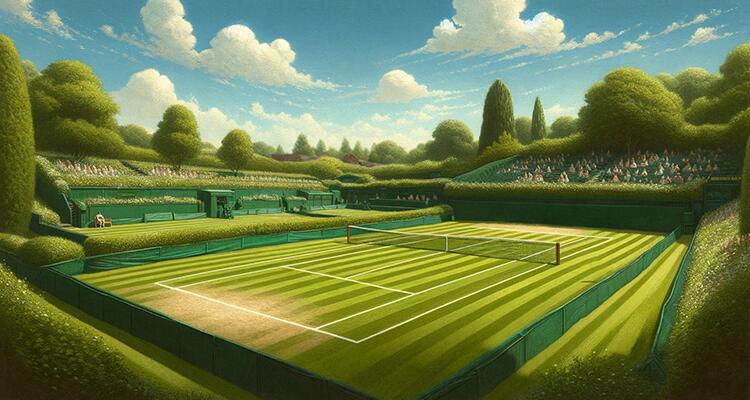
Grass courts are synonymous with speed and tradition. The ball skids quickly off the surface, leading to shorter, more explosive points.
As a result, this surface demands precision, favors players with strong serve-and-volley skills, and rewards those with fast reflexes who can close out points. However, the rarity and maintenance requirements of grass courts add a layer of exclusivity to their presence in the sport.
Grass courts were first introduced in the late 18th century and are most common in the United Kindom and Australia, with some prevalence in the northeastern portion of the United States.
Characteristics
Tennis clubs grow grass courts, much like you’d grow a lawn, but with extreme attention to detail. Maintenance crews lay seed over the topsoil, which is grown and then mowed to a few millimeters in height, precisely 8 mm or 5/16 of an inch if you’re Wimbledon.
The ground, soil, and type of grass all significantly affect how the ball behaves. It skids and bounces low, rewarding players with big serves and proficient volleying. The game’s speed on grass is unmatched, making it a favorite for players with a strong attacking game.
Grass courts are the easiest on a player’s body, providing ample cushion underfoot. However, players must be extra cautious when damp, as the surface can become extremely slippery.
Maintenance
However, grass courts are not without their challenges. They require extensive maintenance to keep them in ideal playing condition, from regular mowing to ensuring the soil’s moisture levels are just right.
Additionally, grass courts are most susceptible to wear and tear, often leading to uneven bounces with heavy use, which you’ll notice is readily apparent from the start to finish of a professional tennis tournament.
Footwear Considerations
The court surface is natural grass, which can vary in type but typically includes species like perennial ryegrass for durability and speed. In 2001, Wimbledon transitioned from a blend of 70% perennial ryegrass and 30% red fescue to 100% perennial ryegrass to improve durability as modern play and longer rallies increase the wear on courts.
Ideal footwear for grass courts includes pimples or small nubs on the outsole for better grip on the slippery surface. These nubs allow players to move swiftly and change direction quickly without losing traction. However, an all-court or herringbone outsole is acceptable, especially if you’re not playing on the surface frequently.
Successful Grass Court Players
The following table showcases the 20 ATP players in the Open Era with the most grass court titles.
| Rank | Country | Name | Grass Titles |
| 1 | Switzerland | Roger Federer | 19 |
| 2 | USA | Pete Sampras | 10 |
| 3 | USA | Stan Smith | 9 |
| 3 | USA | Jimmy Connors | 9 |
| 5 | Australia | Rod Laver | 8 |
| 5 | Australia | Ken Rosewall | 8 |
| 5 | Russia | Alex Metreveli | 8 |
| 5 | USA | John McEnroe | 8 |
| 5 | Australia | Lleyton Hewitt | 8 |
| 5 | Great Britain | Andy Murray | 8 |
| 5 | Serbia | Novak Djokovic | 8 |
| 12 | Australia | John Newcombe | 7 |
| 12 | Australia | Tony Roche | 7 |
| 12 | Sweden | Bjorn Borg | 7 |
| 12 | Germany | Boris Becker | 7 |
| 16 | USA | Arthur Ashe | 6 |
| 16 | Australia | Mark Edmondson | 6 |
| 16 | India | Vijay Amritraj | 6 |
| 19 | USA | Johan Kriek | 5 |
| 19 | Sweden | Stefan Edberg | 5 |
Clay Courts

Unlike the quick pace of grass, clay courts slow the game down. The granular surface grabs the ball, leading to longer rallies and favoring resilient players with tactical prowess.
Players who excel on clay are often patient, with strong, heavy topspin groundstrokes and an elevated tolerance for physical exertion. When damp, clay courts play slowest, neutralizing the bigger weapons of high-powered players, while hotter, dry conditions speed up play.
Most resources widely credit eleven-time Wimbledon champion William Renshaw with the first iteration of clay tennis courts, which he created with crushed red pots to protect grass courts from the summer heat. However, it’s hotelier Georges Henri Gougoltz, who ran the Beau-Site luxury hotel in Cannes, France, and covered his weathered grass courts with clay that is more likely responsible for their existence.
Red clay is the most common surface in Europe and Latin America, whereas Har-Tru is less popular overall and most prevalent in the mid-Atlantic and southern United States.
Characteristics
Clay courts are crafted from natural crushed brick, stone, or shale, topped with a layer of fine clay particles to create a rather slick or slippery surface that significantly impacts ball behavior.
The ball bounces higher and moves slower on clay, rewarding players who excel in methodically constructing points and using topspin to their advantage. This surface is particularly well-suited for baseline players, allowing them to showcase their endurance and strategic aptitude.
Another attribute of clay courts is that they’re relatively forgiving on a player’s body, especially compared to hard courts.
Maintenance
Maintaining a clay court is an art in itself. The surface demands regular watering to prevent it from drying out and cracking, and maintenance crews must roll and brush to maintain its consistency and playability.
These courts can change character with the weather; they play slower when wet and faster as they dry. This variability adds an additional layer of strategy to matches played on clay, mainly because these characteristics can change daily with the forecast.
Footwear Considerations
The most common materials for clay courts are red clay, made from crushed brick, and green clay, or Har-Tru, made from crushed metabasalt. Here are some comparative notes between the two:
- Composition: Red clay is crushed brick, Har-Tru is crushed basalt
- Speed: Red clay is slower than Har-Tru
- Traction: Red clay is less slippery than Har-Tru
- Bounces: Red clay is less predictable than Har-Tru
- Maintenance: Red clay is more expensive to maintain than Har-Tru
Footwear for clay courts features an outsole with a full herringbone tread pattern designed to prevent clay from lodging in the sole, which it naturally releases as the shoe twists and flexes while also providing maximum grip and sliding control. You’ll also find these shoes tend to use less mesh in the upper to prevent dirt and debris from entering the shoe.
Most Successful Clay Court Players
The following table showcases the 20 ATP players in the Open Era with the most clay court titles.
| Rank | Country | Player | Clay Titles |
| 1 | Spain | Rafael Nadal | 63 |
| 2 | Argentina | Guillermo Vilas | 49 |
| 3 | Austria | Thomas Muster | 40 |
| 4 | Sweden | Bjorn Borg | 32 |
| 4 | Spain | Manuel Orantes | 32 |
| 6 | Romania | Ilie Nastase | 30 |
| 7 | USA | Ivan Lendl | 28 |
| 8 | Argentina | Jose Luis Clerc | 21 |
| 9 | Sweden | Mats Wilander | 20 |
| 10 | Serbia | Novak Djokovic | 19 |
| 11 | Ecuador | Andres Gomez | 16 |
| 11 | Spain | Carlos Moya | 16 |
| 13 | Spain | Jose Higueras | 15 |
| 14 | Australia | Rod Laver | 14 |
| 14 | USA | Eddie Dibbs | 14 |
| 14 | Spain | Alberto Berasategui | 14 |
| 14 | Brazil | Gustavo Kuerten | 14 |
| 18 | Hungary | Balazs Taroczy | 13 |
| 18 | Spain | Emilio Sanchez | 13 |
| 18 | Spain | Sergi Bruguera | 13 |
Hard Courts
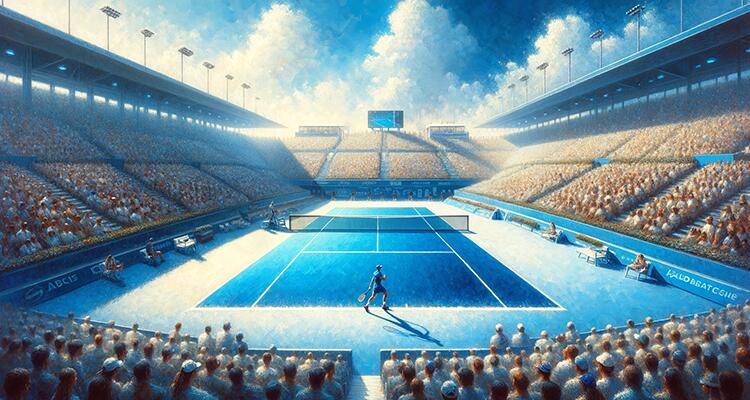
Hard courts offer a middle ground in terms of speed and playability compared to grass and clay. Although performance can vary significantly based on the amount of sand in the top acrylic layer, they generally provide a consistent bounce. Their predictability makes them a favorite among players with a balanced all-court game and a few big weapons, allowing for a blend of speed, power, and tactical play.
These courts didn’t enter the tournament scene until the 1940s, but their popularity has endured due to their practicality and durability, and they are now the most prevalent surface worldwide.
Characteristics
Constructed from layers of acrylic over a concrete or asphalt foundation, hard courts offer a reliable bounce, contributing to a game that’s faster than clay but slower than grass. The acrylic surface can be adjusted to modify the speed of play, allowing club owners and tournament organizers to tailor the court’s performance to their desired preference.
For example, the courts at the Cincinnati Masters are notoriously fast, while the playing surfaces in Indian Wells and Miami are considerably slower, which dictates player success and strategy.
Maintenance
Hard courts boast a resilience that makes them ideally suited for high-volume play in various climates. While they require less day-to-day maintenance than grass or clay courts, they need periodic patching to repair cracks and complete resurfacing every four to five years to maintain the quality of the playing surface.
Overall, the durability and relatively straightforward upkeep of hard courts makes them a popular choice for facilities worldwide, with a higher prominence in the United States.
Footwear Considerations
As the name suggests, hard courts are unforgiving, and the acrylic top layer is abrasive, so choosing proper footwear is crucial.
The surface demands durability and comfort, so shoes designed for hard court play often feature reinforced toe areas, enhanced cushioning to absorb shock, and soles made with highly durable rubber compounds. The most common tread pattern is typically herringbone, with manufacturers modifying the traditional design to balance durability and traction.
Successful Hard Court Players
The following table showcases the 20 ATP players in the Open Era with the most hard court titles.
| Rank | Country | Player | Hard Court Titles |
| 1 | Switzerland | Roger Federer | 71 |
| 1 | Serbia | Novak Djokovic (Active) | 71 |
| 3 | USA | Andre Agassi | 46 |
| 4 | USA | Jimmy Connors | 45 |
| 5 | USA | Pete Sampras | 36 |
| 6 | Great Britain | Andy Murray | 34 |
| 7 | USA | Ivan Lendl | 31 |
| 8 | Australia | Rod Laver | 26 |
| 9 | Spain | Rafael Nadal | 25 |
| 10 | Sweden | Stefan Edberg | 23 |
| 11 | USA | Stan Smith | 22 |
| 11 | USA | John McEnroe | 22 |
| 13 | USA | Michael Chang | 21 |
| 13 | USA | Andy Roddick | 21 |
| 15 | Australia | Lleyton Hewitt | 20 |
| 16 | Romania | Ilie Nastase | 18 |
| 16 | Argentina | Juan Martin Del Potro (Active) | 18 |
| 16 | Russia | Daniil Medvedev (Active) | 18 |
| 19 | Australia | John Newcombe | 17 |
| 19 | USA | Jim Courier | 17 |
Carpet Courts
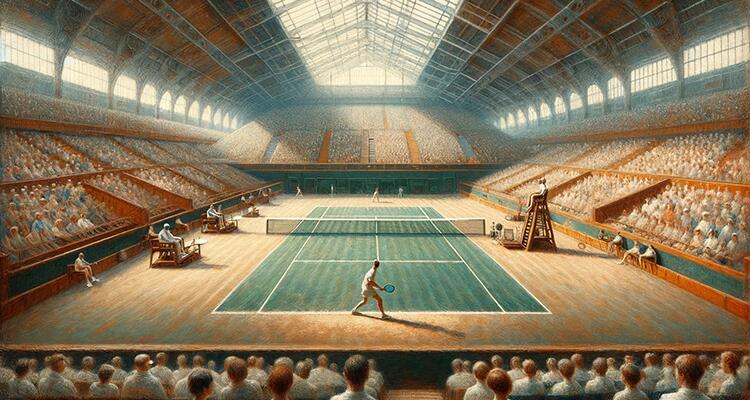
Carpet courts come in several forms, but more broadly, as the International Tennis Federation describes them, they are “textile or polymeric material supplied in rolls or sheets of finished product,” offering a slick and fast playing surface. As such, many resources and online conversations lump artificial grass into carpet courts.
Like traditional grass, carpet plays fast with low bounces, rewarding players with effective serves and who are comfortable moving to the net to take control and close out points on their terms.
Carpet courts gained favor in the 1980s, and historically, they’ve been most popular for indoor play in European countries and regions where natural elements make traditional court upkeep challenging.
Characteristics
Carpet comes in several varieties, but the two most common are the rubberized version and synthetic grass. The former is relatively smooth and feels soft underfoot, while the latter incorporates sand and is similar to turf, which is typical with many other sports.
Carpet courts are known for their speed, making the game extremely fast-paced. The bounce is consistent, but the quickness of the surface rewards players with powerful serves and fast reflexes.
Maintenance
Carpet courts are durable, require little maintenance, and are straightforward to replace when necessary. During their peak, their ease of installation made them popular for converting indoor venues designed for other sports like basketball into tennis courts.
While favored for their practicality, their use has dwindled significantly, driven partly by the ATP’s controversial abandonment of the surface in 2009 due to concerns over uniformity and player safety and the WTA dropping them from their last tournament in 2018.
Footwear Considerations
Playing on rubberized carpet courts requires specialized shoes with smooth outsoles that don’t have a tread pattern because the surface has a natural grip. Traditional clay and all-court outsoles would provide too much grip, leading to dangerous hangups and ankle injuries.
However, if you’re playing on synthetic grass, clay court shoes are ideal as the courts incorporate sand.
Successful Carpet Court Players
The following table showcases the 20 ATP players in the Open Era with the most carpet court titles.
| Rank | Country | Name | Carpet Titles |
| 1 | USA | Jimmy Connors | 43 |
| 1 | USA | John McEnroe | 43 |
| 3 | USA | Ivan Lendl | 33 |
| 4 | Germany | Boris Becker | 26 |
| 5 | Australia | Rod Laver | 24 |
| 6 | Sweden | Bjorn Borg | 23 |
| 7 | USA | Arthur Ashe | 22 |
| 8 | Romania | Ilie Nastase | 15 |
| 8 | USA | Pete Sampras | 15 |
| 10 | Croatia | Goran Ivanisevic | 14 |
| 11 | USA | Stan Smith | 13 |
| 12 | Sweden | Stefan Edberg | 11 |
| 12 | Russia | Yevgeny Kafelnikov | 11 |
| 14 | Netherlands | Tom Okker | 10 |
| 15 | Australia | John Newcombe | 9 |
| 15 | USA | Brian Gottfried | 9 |
| 15 | USA | Michael Chang | 9 |
| 18 | Australia | Ken Rosewall | 8 |
| 18 | Poland | Wojtek Fibak | 8 |
| 20 | Great Britain | Mark Cox | 7 |
Artificial Clay & Grass
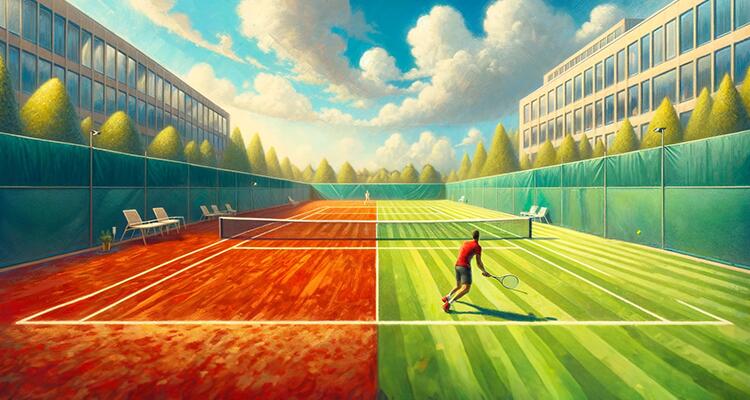
In the diverse world of tennis, artificial courts offer unique alternatives to traditional surfaces with distinct benefits and challenges. While less popular than their grass, clay, and hard counterparts, artificial courts help make tennis more accessible and adaptable.
Artificial Clay
Artificial clay courts aim to replicate the slow playing conditions and high bounce of natural clay surfaces without intensive maintenance. They are made with a base of synthetic carpet covered with fine clay particles designed to mimic traditional clay courts but with less maintenance, offering a durable and consistent playing experience.
Characteristics
The ball bounce on artificial clay is similar to natural clay, allowing for extended rallies and a game that tests endurance and strategy. However, the surface does play faster, altering match dynamics.
Maintenance
One of the most significant advantages of artificial clay is its low maintenance compared to natural clay courts.
It doesn’t need regular watering or the same level of care to prevent deterioration, making it a cost-effective option for many clubs. Despite these benefits, artificial clay hasn’t reached the same level of popularity, partly due to purists’ preference for the traditional clay court experience.
Footwear Considerations
Like natural clay courts, shoes with a full herringbone tread pattern are ideal for artificial clay to release clay naturally, provide the necessary grip, and allow for smooth and effective sliding.
Artificial Grass
Artificial grass courts aim to offer the look and feel of natural grass without the high maintenance and costs. These courts typically use synthetic fibers made of nylon, polypropylene, or polyethylene that mimic the softness and bounce of grass, providing an aesthetically pleasing and playable surface year-round regardless of the climate.
Helpful Tip: It’s worth noting that resources often lump artificial grass under carpet courts, which we covered earlier.
Characteristics
To a degree, artificial grass resembles natural grass, with a fast game and low bounce. However, synthetic grass will usually offer slightly more predictable bounce and speed because you’re not fighting the wear and tear of natural grass, which inevitably leads to some awkward bounces.
Maintenance
The primary advantage of artificial grass is its durability and minimal upkeep, requiring no mowing or watering. While favored for its practicality, especially in clubs and private homes, synthetic grass courts lack the originality and prestige of traditional grass courts like Wimbledon or those found at the International Tennis Hall of Fame.
Footwear Considerations
Like traditional grass courts, footwear with small, closely spaced pimples or nubs enhances grip and facilitates movement on artificial grass courts. However, I find a broader range of shoes adequate, including clay court shoes and all-court options popular for hard courts.
Grand Slam Surfaces
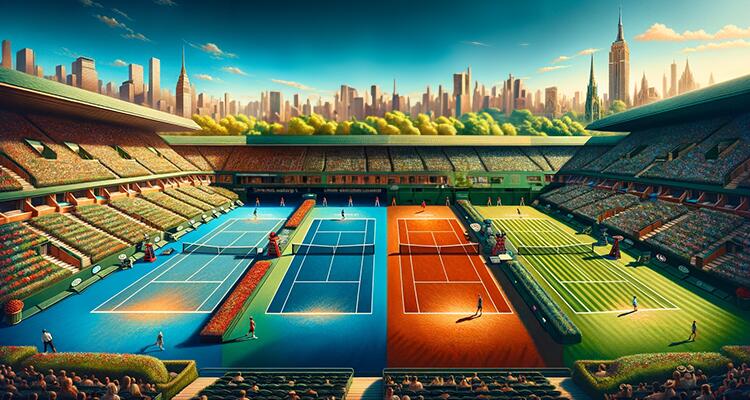
Each year, the world’s best players compete at the four Grand Slam tournaments on three types of tennis courts: hard, clay, and grass.
Each surface significantly impacts the game’s dynamics, presents a unique challenge, and shapes the character of each event, testing the versatility and resilience of the athletes.
Australian Open – Hard Court
Kicking off the Grand Slam calendar, the Australian Open is played on a cushioned hard court developed by GreenSet. This medium-fast surface favors players with powerful baseline shots and those adept at absorbing and redirecting pace.
French Open (Roland Garros) – Clay Court
The red clay courts of Roland Garros slow down the ball and produce a high bounce, rewarding players with stamina, patience, and the ability to construct points meticulously. Due to the intensity of rallies, many consider it the ultimate test of endurance in tennis.
Wimbledon – Grass Court
The oldest tennis tournament in the world, Wimbledon, is synonymous with its fast-playing grass courts. The low bounce and quick pace favor serve-and-volley players and those who can adapt to the surface’s unpredictable nature.
US Open – Hard Court
Played on Laykold hard courts, the US Open offers a high-bouncing and somewhat faster-playing surface than the Australian Open. This tournament tests a player’s ability to handle power and speed, benefiting aggressive baseline players and those with a strong serve.
Elite Tournament Surfaces
Here are some of the world’s biggest ATP and WTA tennis tournaments outside the Grand Slam events and their surfaces.
ATP
| Tournament | Location | Surface | Level |
| Australian Open | Melbourne, Australia | Hard Court | Grand Slam |
| French Open (Roland Garros) | Paris, France | Clay Court | Grand Slam |
| Wimbledon | London, England | Grass Court | Grand Slam |
| US Open | New York, USA | Hard Court | Grand Slam |
| ATP Finals | Turin, Italy | Hard Court (Indoor) | Finals |
| Indian Wells Masters | Indian Wells, USA | Hard Court | Masters 1000 |
| Miami Open | Miami, USA | Hard Court | Masters 1000 |
| Monte-Carlo Masters | Monte Carlo, Monaco | Clay Court | Masters 1000 |
| Madrid Open | Madrid, Spain | Clay Court | Masters 1000 |
| Italian Open (Rome Masters) | Rome, Italy | Clay Court | Masters 1000 |
| Canadian Open (Rogers Cup) | Toronto/Montreal, Canada | Hard Court | Masters 1000 |
| Cincinnati Masters | Cincinnati, USA | Hard Court | Masters 1000 |
| Shanghai Masters | Shanghai, China | Hard Court | Masters 1000 |
| Paris Masters | Paris, France | Hard Court (Indoor) | Masters 1000 |
| Rotterdam Open | Rotterdam, Netherlands | Hard Court (Indoor) | ATP 500 |
| Rio Open | Rio de Janeiro, Brazil | Clay Court | ATP 500 |
| Barcelona Open | Barcelona, Spain | Clay Court | ATP 500 |
| Dubai Tennis Championships | Dubai, UAE | Hard Court | ATP 500 |
| Acapulco Open | Acapulco, Mexico | Hard Court | ATP 500 |
| Halle Open (Gerry Weber Open) | Halle, Germany | Grass Court | ATP 500 |
| Queen’s Club Championships | London, England | Grass Court | ATP 500 |
| Swiss Indoors Basel | Basel, Switzerland | Hard Court (Indoor) | ATP 500 |
| Vienna Open | Vienna, Austria | Hard Court (Indoor) | ATP 500 |
| Japan Open | Tokyo, Japan | Hard Court | ATP 500 |
| Hamburg European Open | Hamburg, Germany | Clay Court | ATP 500 |
| Washington Open | Washington, D.C., USA | Hard Court | ATP 500 |
| China Open | Beijing, China | Hard Court | ATP 500 |
WTA
| Tournament | Location | Surface | Level |
| Australian Open | Melbourne, Australia | Hard Court | Grand Slam |
| French Open (Roland Garros) | Paris, France | Clay Court | Grand Slam |
| Wimbledon | London, England | Grass Court | Grand Slam |
| US Open | New York, USA | Hard Court | Grand Slam |
| WTA Finals | Shenzhen, China | Hard Court (Indoor) | WTA Finals |
| Qatar Open | Doha, Qatar | Hard | WTA 1000 |
| Dubai Championships | Dubai, UAE | Hard | WTA 1000 |
| Indian Wells Open | Indian Wells, USA | Hard | WTA 1000 |
| Miami Open | Miami, USA | Hard | WTA 1000 |
| Madrid Open | Madrid, Spain | Clay Court | WTA 1000 |
| Italian Open | Rome, Italy | Clay Court | WTA 1000 |
| Canadian Open | Toronto/Montreal, Canada | Hard | WTA 1000 |
| Cincinnati Open | Cincinnati, USA | Hard | WTA 1000 |
| China Open | Beijing, China | Hard | WTA 1000 |
| Wuhan Open | Wuhan. China | Hard | WTA 1000 |
| Brisbane International | Brisbane, Australia | Hard | WTA 500 |
| Adelaide International | Adelaide, Australia | Hard | WTA 500 |
| Upper Austria Ladies Linz | Linz, Austria | Hard (Indoor) | WTA 500 |
| Mubadala Abu Dhabi Open | Abu Dhabi, UAE | Hard | WTA 500 |
| Cymbiotika San Diego Open | San Diego, USA | Hard | WTA 500 |
| Credit One Charleston Open | Charleston, USA | Clay | WTA 500 |
| Porsche Tennis Grand Prix | Stuttgart, Germany | Clay (Indoor) | WTA 500 |
| Internationaux de Strasbourg | Strasbourg, France | Clay | WTA 500 |
| Berlin Ladies Open | Berlin, Germany | Grass | WTA 500 |
| Bad Homburg Open | Bad Homburg, Germany | Grass | WTA 500 |
| Rothesay International | Eastbourne, UK | Grass | WTA 500 |
| Mubadala Citi DC Open | Washington, D.C., USA | Hard | WTA 500 |
| Abierto GNP Seguros | Monterrey, Mexico | Hard | WTA 500 |
| Guadalajara Open Akron | Guadalajara, Mexico | Hard | WTA 500 |
| Korea Open | Seoul, South Korea | Hard | WTA 500 |
| Zhengzhou Open | Zhengzhou, China | Hard | WTA 500 |
| Toray Pan Pacific Open | Tokyo, Japan | Hard | WTA 500 |
Competing at the highest level on different surfaces is a true testament to a player’s skill, strategy, and adaptability, highlighting why the surface is so integral to the fabric of tennis.
Wrapping Up
Exploring the diverse world of tennis courts, it’s clear that the surface plays a crucial role in shaping the game. From the iconic grass of Wimbledon to the red clay of Roland Garros, each type of court presents unique challenges, contributing to the character of our sport.
This understanding also reveals a layer of complexity within tennis and showcases how each surface influences player styles, strategy, and performance. Furthermore, it helps to enrich our appreciation for the sport’s diversity and the adaptability required of its athletes.
Hopefully, this guide has helped provide a deeper, more nuanced understanding of the different types of tennis courts. Feel free to share any questions or thoughts in the comments section below.
Play Better Tennis
Improve your game alongside our community of tennis players
Why join?
Discussion Boards
Join the conversation with other members of the community.
5 Point Friday
Read our weekly recap of the 5 most interesting things we dig up in tennis.

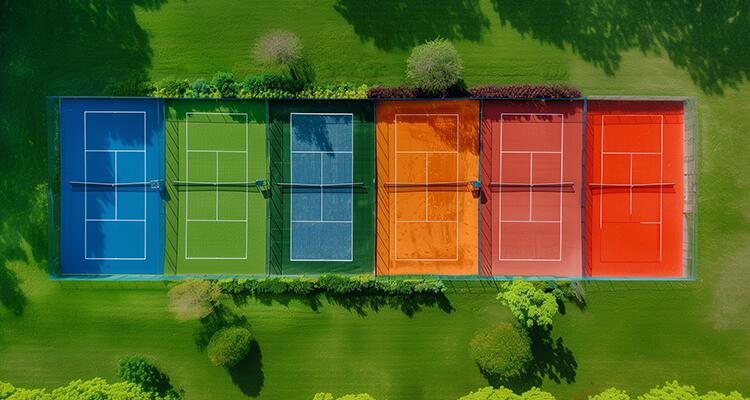

Leave a Reply
Want to join the discussion?Feel free to contribute!